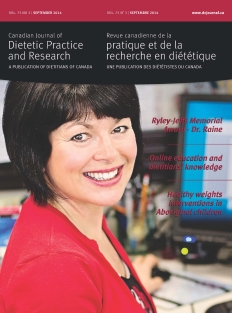Abstract
Purpose: Effective workplace wellness programs, featuring supports for healthy eating and active lifestyle behaviours, have been found to reduce health risks and the associated economic burdens for individuals, organizations, and their communities. As part of a larger study, the purpose of this research was to engage volunteer participants from a university community to identify healthy eating and active lifestyle barriers and supports.
Methods: An ethics-approved, action-research design with photo elicitation technique was used to engage employees and students. Data were analyzed using qualitative analysis software.
Results: Participants identified barriers and both current and future supports for healthy eating and active lifestyle on campus. These were coded under the sub-themes of food environment, food and nutrition quality, physical environment, physical activity, fitness centre, and awareness/communication.
Conclusion: Photo elicitation was determined to be an effective technique to engage participants. Despite many supports, members of the university community still found it difficult to follow healthy eating and active lifestyle behaviours; however, a number of practical future supports were identified. This study also provided valuable insight into the role that dietitians can play in the development of successful wellness programs.
Résumé
Objectif. Il a été démontré que les programmes de mieux-être au travail efficaces qui favorisent la saine alimentation et un style de vie actif réduisent les risques pour la santé ainsi que le fardeau économique associé pour les personnes, les organisations et les communautés. L'objectif de cette recherche, qui faisait partie d'une plus vaste étude, consistait à recruter des participants volontaires au sein d'une communauté universitaire dans le but d'identifier les éléments qui favorisent ou freinent une saine alimentation et un style de vie actif.
Méthodes. Un plan de recherche-action ayant fait l'objet d'une approbation éthique et faisant appel à la technique de photo-interview a été utilisé pour faire participer des employés et des étudiants. Les données ont été analysées à l'aide d'un logiciel d'analyse quantitative.
Résultats. Les participants ont identifié des obstacles ainsi que des éléments actuels et à venir qui pourraient favoriser une saine alimentation et un style de vie actif sur le campus. Ces résultats ont été codés en fonction des sous-thèmes suivants : environnement alimentaire, qualité des aliments et de la nutrition, environnement physique, activité physique, centre de conditionnement physique et sensibilisation/communication.
Conclusion. La photo-interview s'est avérée être une technique efficace pour mobiliser les participants. Malgré les nombreux éléments favorables, les membres de la communauté universitaire trouvaient tout de même difficile d'adopter une saine alimentation et un style de vie actif. Cependant, un certain nombre d’éléments favorables pratiques ont été identifiés pour l'avenir. Cette étude a également fourni des renseignements précieux sur le rôle que les diététistes peuvent jouer dans la mise au point de programmes de mieux-être efficaces.



